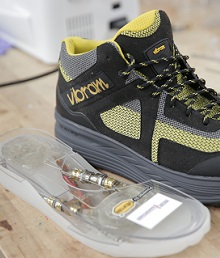February 25, 2016
Power Walk With Phone-Charging Footwear
 Instead of just counting your steps, why not use them to charge your smartphone too? Researchers from the mechanical engineering department at the University of Wisconsin-Madison have come up with an innovative way to harvest and store the energy generated by walking to power mobile electronic devices.
Instead of just counting your steps, why not use them to charge your smartphone too? Researchers from the mechanical engineering department at the University of Wisconsin-Madison have come up with an innovative way to harvest and store the energy generated by walking to power mobile electronic devices.
“Human walking carries a lot of energy,” says Professor Tom Krupenkin, who developed the technology with J. Ashley Taylor, a senior scientist at the university. “Theoretical estimates show that it can produce up to 10 watts per shoe, and that energy is just wasted as heat. A total of 20 watts from walking is not a small thing, especially compared to the power requirements of the majority of modern mobile devices.”
Tapping into that energy could power anything from laptops to flashlights. Power-generating shoes could also be useful for the military to replace heavy batteries currently used to power radios, GPS units and night-vision goggles in the field, according to the researchers.
Krupenkin and Taylor describe the technology they created in a recent article published in the journal Scientific Reports. The researchers convert mechanical energy generated by walking into electrical energy through a process known as “reverse electrowetting,” where a conductive liquid interacts with a nanofilm-coated device. Because the process works better with high-frequency mechanical sources that vibrate or rotate quickly, the researchers came up with something they call the “bubbler” method to compensate: The bubbler device, which contains no moving mechanical parts, consists of two flat plates separated by a small gap filled with conductive liquid. The bottom plate is covered with tiny holes through which pressurized gas forms bubbles, which pop when they reach the top plate. The speedy, repetitive bubble growth generated an electrical charge of around 10 watts per square meter in initial testing, though Krupenkin says it could theoretically generate as much as 10 kilwatts per square meter as the concept is further developed.
The University of Wisconsin researchers are hoping to commercialize their footwear-embedded energy harvester through their startup company, InStep NanoPower. The shoe harvester could power devices through a charging cable, or it could be integrated with other electronic devices embedded in a shoe, such as a Wi-Fi hot spot that acts as a “middleman” between mobile devices and a wireless network. The latter solution dramatically cuts the power requirements of a wireless device, improving battery life by as much as 10 times.
Could be the coolest development in footwear-based technology since the shoe phone!